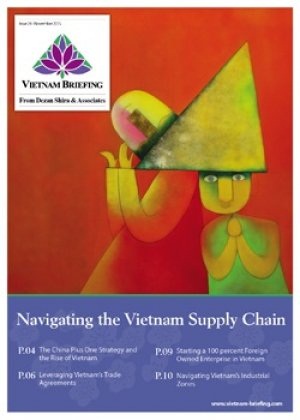Vietnam Market Watch: Growth Projections, Food Price Inflation, and IMF assistance with Development Goals

Cost of Food Increasing Exponentially
The General Statistic Office (GSO) has revealed that the average Vietnamese citizen spends nearly three times more on food than they did in 2004. In the coming year, annual spending on food and foodstuff is expected to rise from a 2015 high of US $ 250 to US $ 256 in 2016.
In 2015, the average expense on food per person per month was around US $21. In a few metropolitans, this figure has nearly doubled. Đinh Thị Mỹ Loan, Chairwoman of Vietnam Retailers Association (VRA) attributed the new food consumption and expenditure pattern to the growth of the retail sector in the country. While, only 15 percent of consumers buy food and food products from supermarkets, the growth of the sector will boost the food consumption and associated expenditure in the coming months.
 RELATED: Pre-Investment Services from Dezan Shira & Associates
RELATED: Pre-Investment Services from Dezan Shira & Associates
Independent Report forecasts strong growth economic growth for Vietnam
The Institute of Chartered Accountants in England and Wales (ICAEW) says that Vietnam’s Gross Domestic Product (GDP) will remain between 6-7 percent from 2016 to 2018. The report indicates that Vietnam is the “bright spark” in the ASEAN economy. Vietnam’s growth accelerated to 6.7 percent in 2015, facilitated by new highs in foreign direct investment (FDI) and strong export growth.
The report states that the growth prospects for Vietnam in 2016 are the brightest among ASEAN member states. It also projects that Vietnam will grow at 6.3 percent, which, despite a dip from 2015, is still the highest in ASEAN. The Philippines and Indonesia follow Vietnam with growth rates projected at 6.1 and 5.1 percent respectively.
Economists believe that Vietnam’s growth is based on a competitive domestic economy, low debt, macro-stability, and wage competitiveness. In addition, a number of ASEAN countries have been affected adversely by China’s economic downturn as such countries have large parts of their manufacturing dependent on China. In comparison, Vietnam is relatively insulated from China economically, thus ensuring a healthier growth rate among ASEAN member states.
![]() RELATED: Vietnam’s Aviation Industry Boom – a Golden Opportunity for Budding Aviators
RELATED: Vietnam’s Aviation Industry Boom – a Golden Opportunity for Budding Aviators
IMF to Aid Vietnam in Achieving Development Goals
Christine Lagarde, managing director of the International Monetary Fund (IMF) on 16 March said that the organization was keen to aid Vietnam in achieving its development goals. The IMF wants to develop extensive cooperation with Vietnam, which will include monetary assistance as well as technical training and operational support.
Lagarde said that Vietnam needs to reform, improved labor productivity and domestic competitiveness to ensure sustainable growth. He went on the say that effective reforms will ensure an effective annual growth rate of seven percent next five years. He specially identified improved governance and promotion of democracy as two key areas where reforms were needed. The statement from Lagarde reflects the Vietnam’s economic potential. Analysts believe that Vietnam will develop at a very fast pace if the government is able to implement the necessary reforms smoothly.
|
Asia Briefing Ltd. is a subsidiary of Dezan Shira & Associates. Dezan Shira is a specialist foreign direct investment practice, providing corporate establishment, business advisory, tax advisory and compliance, accounting, payroll, due diligence and financial review services to multinationals investing in China, Hong Kong, India, Vietnam, Singapore and the rest of ASEAN. For further information, please email vietnam@dezshira.com or visit www.dezshira.com. Stay up to date with the latest business and investment trends in Asia by subscribing to our complimentary update service featuring news, commentary and regulatory insight. |

Annual Audit and Compliance in Vietnam 2016
In this issue of Vietnam Briefing, we address pressing changes to audit procedures in 2016, and provide guidance on how to ensure that compliance tasks are completed in an efficient and effective manner. We highlight the continued convergence of VAS with IFRS, discuss the emergence of e-filing, and provide step-by-step instructions on audit and compliance procedures for Foreign Owned Enterprises (FOEs) as well as Representative Offices (ROs).
 Navigating the Vietnam Supply Chain
Navigating the Vietnam Supply Chain
In this edition of Vietnam Briefing, we discuss the advantages of the Vietnamese market over its regional competition and highlight where and how to implement successful investment projects. We examine tariff reduction schedules within the ACFTA and TPP, highlight considerations with regard to rules of origin, and outline the benefits of investing in Vietnam’s growing economic zones. Finally, we provide expert insight into the issues surrounding the creation of 100 percent Foreign Owned Enterprise in Vietnam.
 Tax, Accounting and Audit in Vietnam 2016 (2nd Edition)
Tax, Accounting and Audit in Vietnam 2016 (2nd Edition)
This edition of Tax, Accounting, and Audit in Vietnam, updated for 2016, offers a comprehensive overview of the major taxes foreign investors are likely to encounter when establishing or operating a business in Vietnam, as well as other tax-relevant obligations. This concise, detailed, yet pragmatic guide is ideal for CFOs, compliance officers and heads of accounting who must navigate Vietnam’s complex tax and accounting landscape in order to effectively manage and strategically plan their Vietnam operations.
- Previous Article Public Private Partnerships in Vietnam – Part 1: Industry and Contract Structures
- Next Article Mutterschaftsurlaub in Vietnam









